
NCERT solutions for class 12 chemistry chapter 1 Solid State is provided here is simple and scoring chapter. Students can easily learn the basics of this Solid state chapter by having simple mathematics knowledge. Students can also find solid state class 12 notes here. Solid State in chemistry has great significance to understand basics structure of solids found in earth.
INTEXT EXERCISE
1.1 Why are solids rigid?
Ans: The constituent particles (Atoms or molecules or ions) has strong intermolecular or intramolecular or interionic forces. Due to the presence of these forces these particles are not free to move but only can oscillate about their mean positions. that’s why solids are rigid in nature.
1.2 Why do solids have a definite volume?
Ans: The constituent particles of a solid have strong attraction forces due to these forces, particles are not free to move at given temperature. Thus solids have a definite volume
1.3 Classify the following as amorphous or crystalline solids: Polyurethane, naphthalene, benzoic acid, Teflon, potassium nitrate, cellophane, polyvinyl chloride, fiber glass, copper.
Ans: (i) Crystalline solids: Benzoic acid, naphthalene, potassium nitrate, copper
(ii) Amorphous solids: Polyurethane, Teflon, cellophane, polyvinyl chloride, fiberglass.
1.4 Refractive index of a solid is observed to have the same value along all directions. Comment on the nature of this solid. Would it show cleavage property?
Ans: As the solid has same value of refractive index along all directions, it is isotropic in nature and hence, it is a amorphous solid. Being an amorphous solid, it will not show a clean cleavage and when cut with knife, but will break into pieces with irregular surfaces.
1.5 Classify the following solids in different categories based on the nature of intermolecular forces operating in them: Potassium sulphate, tin, benzene, urea, ammonia, water, zinc sulphide, graphite, rubidium, argon, silicon carbide.
Ans: (i) Metallic solids: Tin (Sn), Rubidium (Rb)
(ii) Ionic solids: Potassium sulphate(K2SO4), zinc sulphide (ZnS)
(iii) Covalent solids: Graphite (C) , silicon carbide (SiC)
(iv) Molecular solids: Benzene(C6H6) , urea (NH2CONH2), ammonia(NH3), water(H2O).
1.6 Solid A is a very hard electrical insulator in solid as well as in molten state and melts at extremely high temperature. What type of solid is it?
Ans: A covalent or network solid.
1.7 Ionic solids conduct electricity in molten state but not in solid state. Explain.
Ans: As we know that ionic solids are very rigid body. The ions present in them are not free to move due to strong electrostatic forces. So, ionic solids do not conduct electricity in solid state but in the molten state, there will be very poor electrostatic forces results in free ions to move. Hence, Ionic solids conduct electricity in molten state but not in solid state
1.8 What type of solids are electrical conductors, malleable and ductile?
Ans: Metallic solids
1.9 Give the significance of a ‘lattice point’.
Ans: In crystalline solids, each constituent particle (atom, molecules, ions or e–) is represented as ‘Points’. These ‘Points’ are known as lattice point.
1.10 Name the parameters that characterise a unit cell.
Ans: A unit cell is characterize by six parameters i.e., a,b,c and 𝛼, 𝛽, 𝛾
(i) The dimensions of unit cell along three edges: a, b and c.
(ii) The angles between the edges:
α (between b and c);
β (between a and c) and
γ (between a and b)
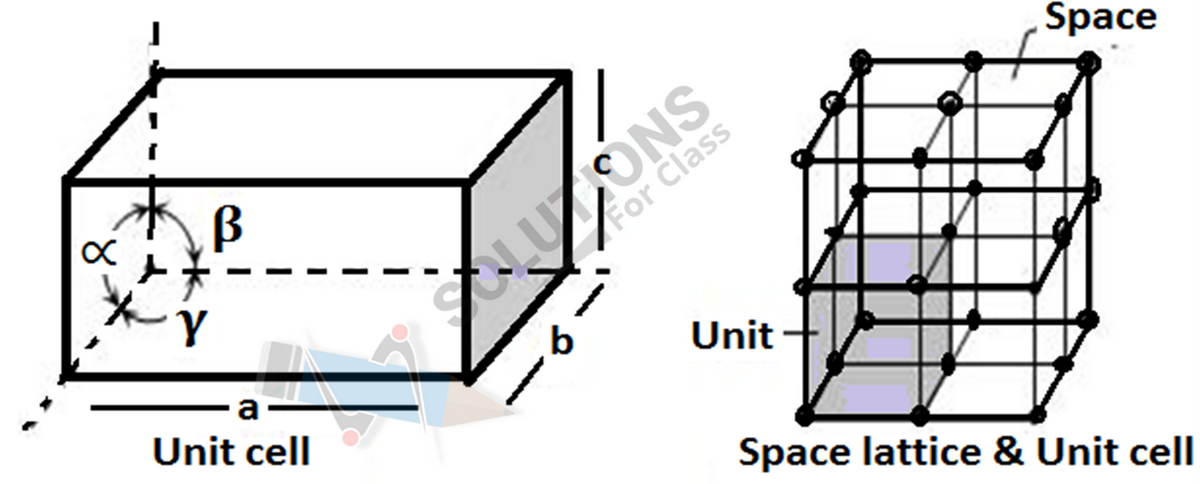
1.11 Distinguish between
(i) Hexagonal and monoclinic unit cells
(ii) Face-centred and end-centred unit cells.
Ans: (i) Hexagonal and monoclinic unit cells
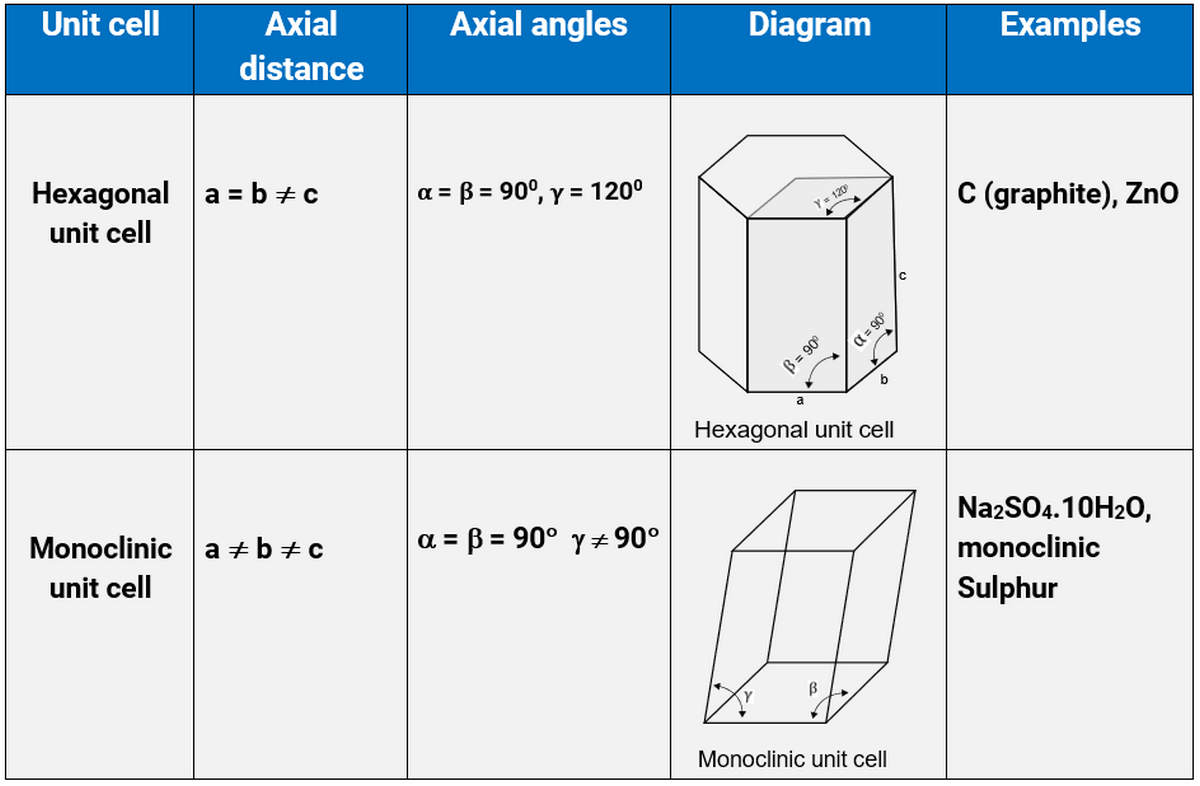
(ii) Face-centred and end- centred unit cells.
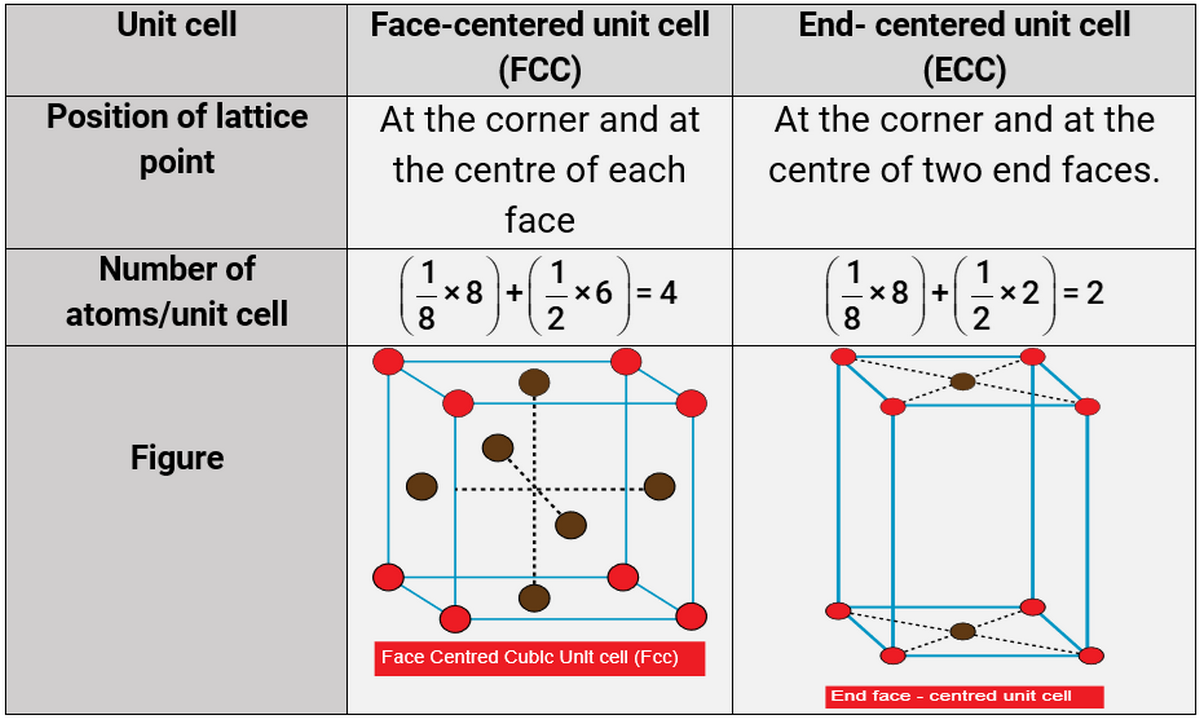
1.12 Explain how much portion of an atom located at (i) corner and (ii) body- centre of a cubic unit cell is part of its neighboring unit cell.
Ans: (i) Any lattice point or atom at the corner is shared by eight unit cells. Hence, each atom contributes its 1/8 th portion to the unit cell.
(ii) Any lattice point or atom at the body centre is not shared by any other unit cells. Hence, this atom is entirely belongs to one unit cell.
1.13 What is the two dimensional coordination number of a molecule in square close-packed layer?
Ans : 4, each atom touches 4 nearest neighboring atoms forming square close-packed layer . Hence, it’s CN = 4
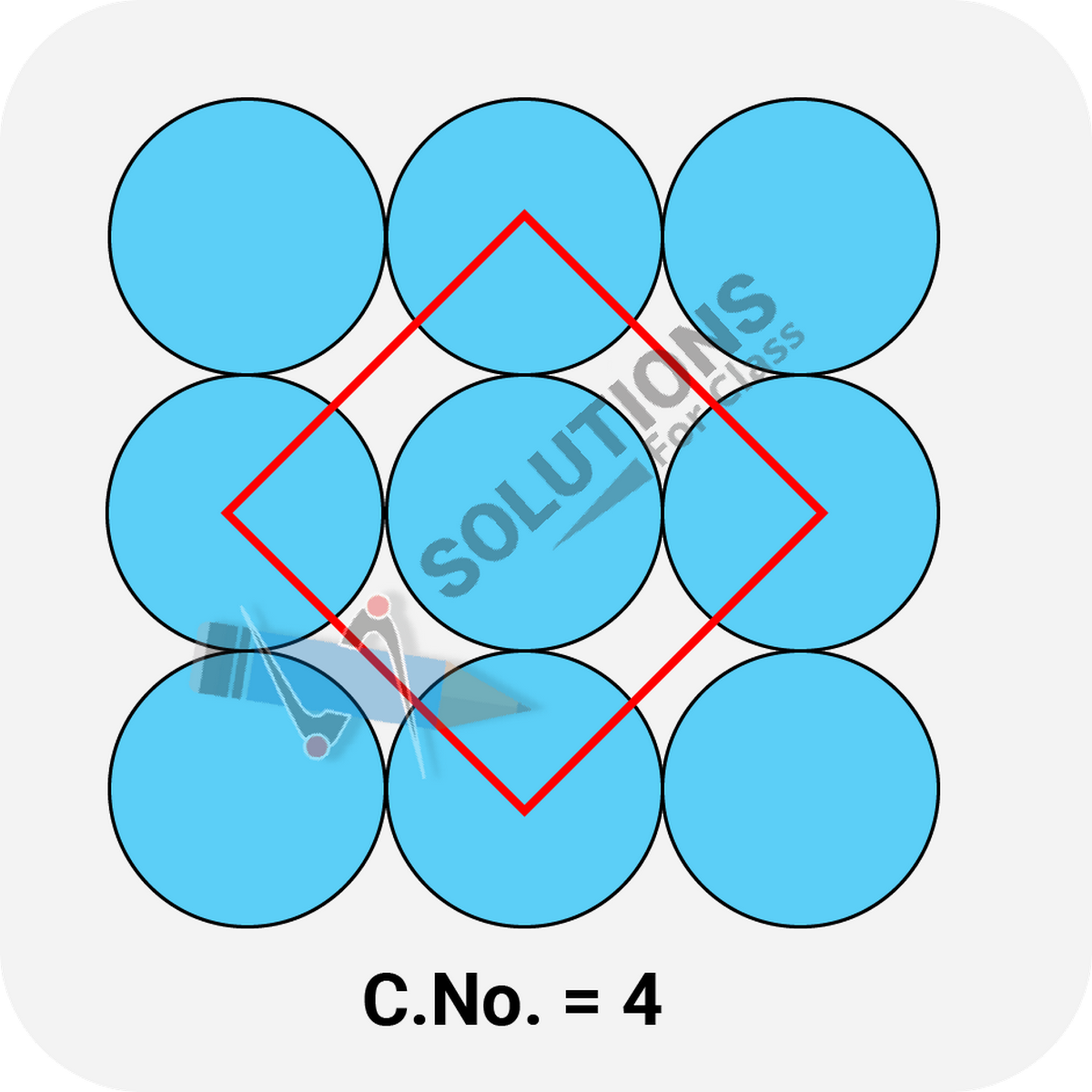
1.14 A compound forms hexagonal close-packed structure. What is the total number of voids in 0.5 mol of it? How many of these are tetrahedral voids?
Ans:
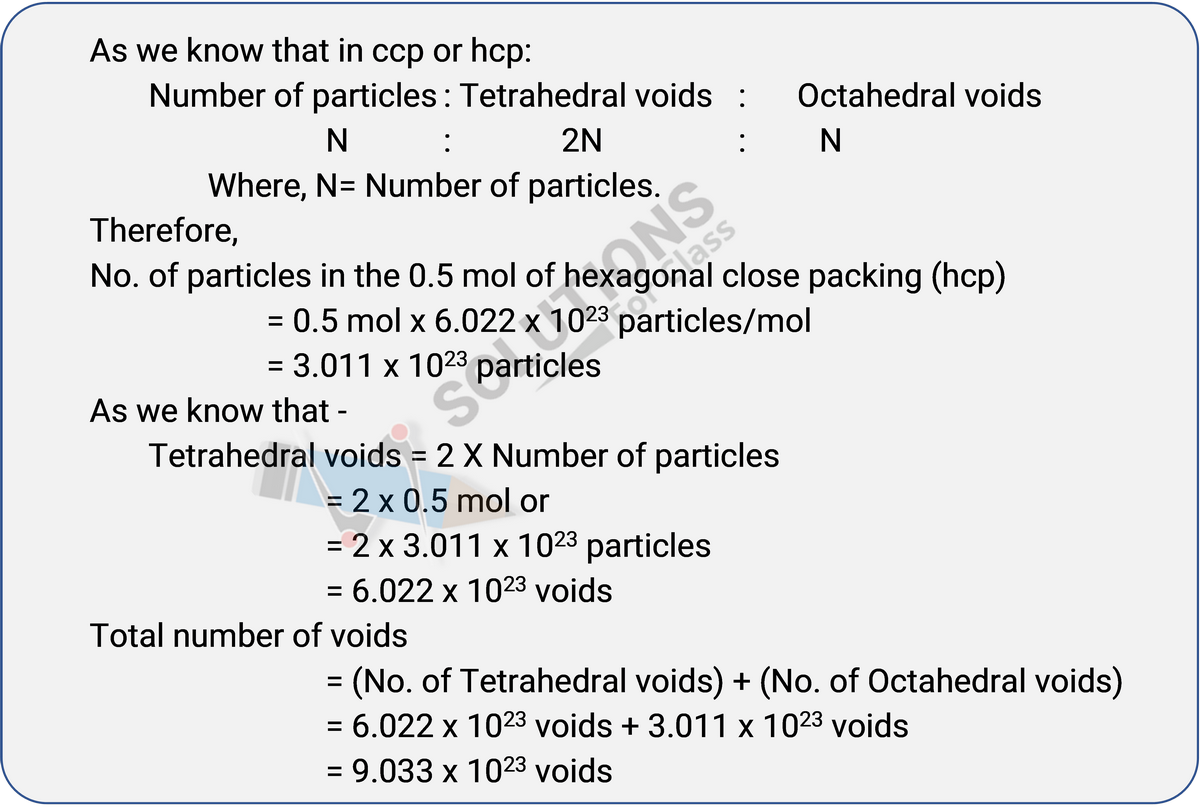
1.15 A compound is formed by two elements M and N. The element N forms ccp and atoms of M occupy 1/3rd of tetrahedral voids. What is the formula of the compound?
Ans:
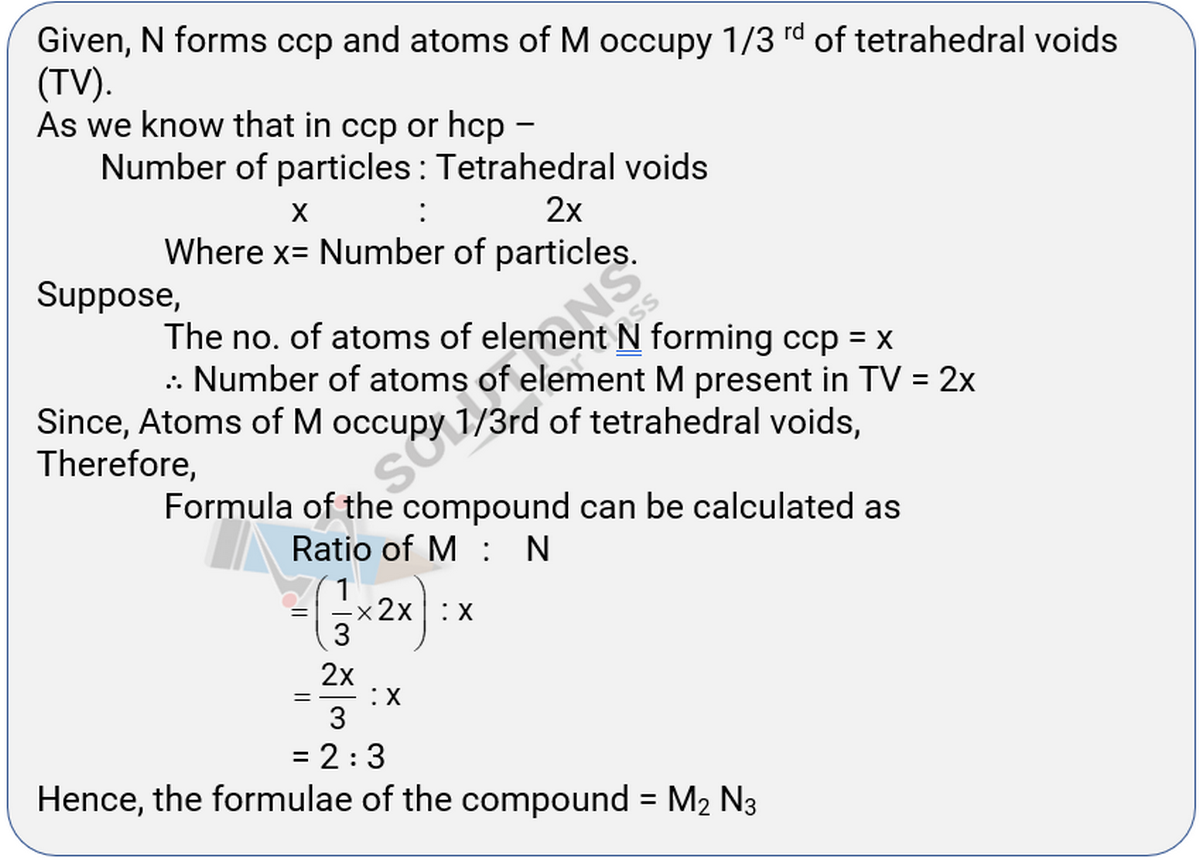
1.16 Which of the following lattices has the highest packing efficiency (i) simple cubic (ii) body-centred cubic and (iii) hexagonal close-packed lattice?
Ans: Packing efficiency of given lattices are :
(i) Simple cubic (scc) = 52.4%
(ii) Body-centred cubic (bcc) = 68%
(iii) Hexagonal close-packed (hcp) = 74%
Hence, hcp lattice has the highest packing efficiency.
1.17 An element with molar mass 2.7×10-2 kg mol-1 forms a cubic unit cell with edge length 405 pm. If its density is 2.7×103 kg m-3, what is the nature of the cubic unit cell?
Ans:
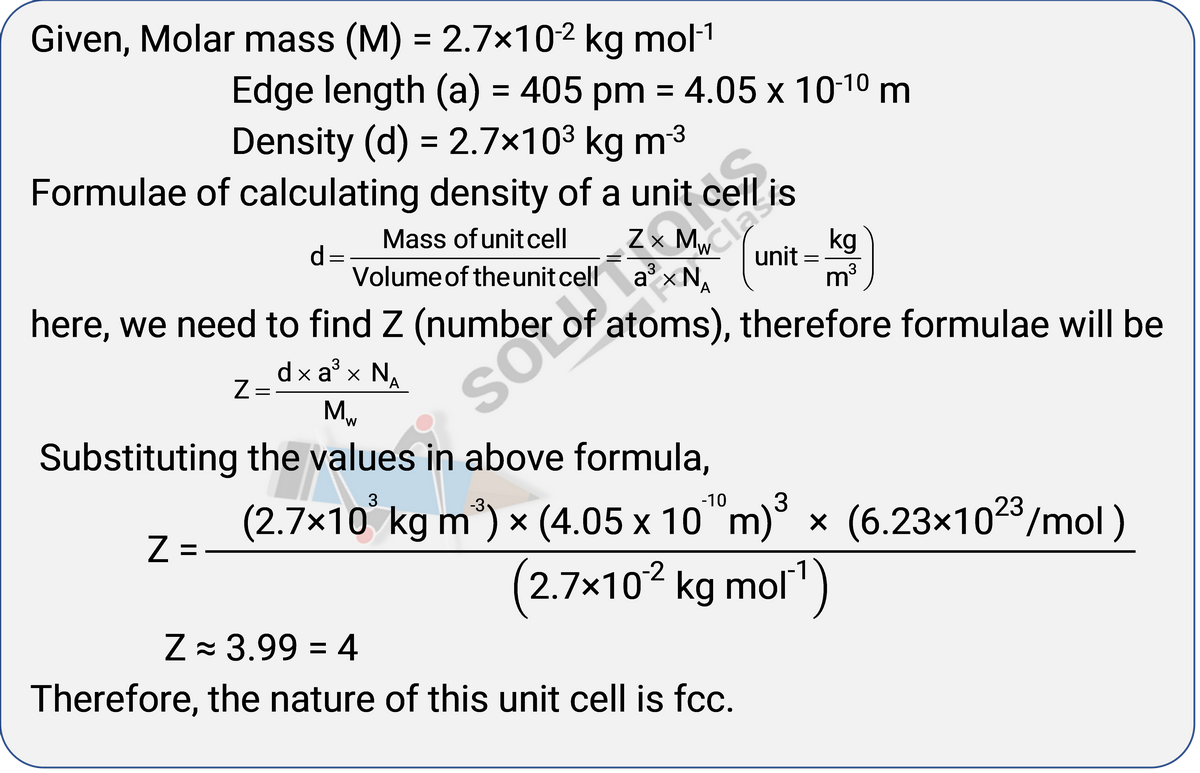
1.18 What type of defect can arise when a solid is heated? Which physical property is affected by it and in what way?
Ans: When a solid is heated, vacancy defect is produced in the crystal. When we heat a solid, some atoms or ions leave their lattice point which results in vacancy defect and decreased density.
1.19 What type of stoichiometric defect is shown by: (i) ZnS (ii) AgBr
Ans: (i) ZnS shows Frenkel defect
(ii) AgBr shows both Frenkel defect and Schottky defect.
.1.20 Explain how vacancies are introduced in an ionic solid when a cation of higher valence is added as an impurity in it.
Ans: when a cation of higher valence (let say SrCl2) is added as an impurity in an ionic solid (let say NaCl), some of the lattice point of original cations (i.e.Na+) are occupied by the higher valency (i.e.Sr2+) . in this condition, to maintain electrical neutrality , each cation of higher valency (Sr2+) replaces two original cations (Na+) and occupies one site of original cation and the other site remains vacant.
1.21 Ionic solids, which have anionic vacancies due to metal excess defect, develop colour. Explain with the help of a suitable example.
Ans: when crystals of NaCl are heated in an atmosphere of sodium vapour (Na(g)), the sodium atoms are deposited on the surface of the crystal. The Cl– ions diffuse from the crystal to its surface and combine with Na atoms, forming NaCl. During this process, the Na atoms on the surface of the crystal lose electrons. These released electrons diffuse into the crystal and occupy the vacant anionic sites, creating F-centres.
This unpaired electron is responsible for the colour. when they absorb energy from the visible light, these electron excites from ground state to higher energy and fall back to ground state. In this process they release energy of specific wavelength which results in yellow color.
1.22 A group 14 element is to be converted into n-type semiconductor by doping it with a suitable impurity. To which group should this impurity belong?
Ans : n-type semiconductor means there is excess of electrons by doping process. Therefore, to convert group 14 element into n-type , it should be doped with group of 15 elements
1.23 What type of substances would make better permanent magnets, ferromagnetic or ferrimagnetic. Justify your answer.
Ans: Ferromagnetic substances make better permanent magnets. Because when these substance are placed in magnetic field, their domains (group of metal ions) get oriented in the directions of magnetic field and a strong magnetic field is produced. Such order of domains persists even when external magnetic field is removed. Hence, the ferromagnetic substance becomes a permanent magnet.
Exercises
1.1 Define the term ‘amorphous’. Give a few examples of amorphous solids.
Ans : Amorphous solids are defined as those substances, in which there is no organised and regular arrangement of its particles, (i.e., atoms, molecules and ions). Due to this, the regular arrangement of the constituting particles has only short range order. In such arrangement, a regular and periodically repeating pattern is observed over short distances only. Examples are rubber, glass, plastics.
1.2 What makes a glass different from a solid such as quartz? Under what conditions could quartz be converted into glass?
Ans: Glass is an amorphous solid made up of SiO4 (tetrahedral) units have only short range of order only. Whereas Quartz is also made up of SiO4 (tetrahedral) units. But have long range of order than glass. Quartz can be converted into glass by first melting and then rapidly cooling it.
1.3 Classify each of the following solids as ionic, metallic, molecular, network (covalent) or amorphous.(i) Tetra phosphorus decoxide (P4O10) (ii) Ammonium phosphate (NH4)3PO4 (iii) SiC (iv) I2 (v) P4 (vi) Plastic (vii) Graphite (viii) Brass (ix) Rb (x) LiBr (xi) Si
Ans:

1.4 (i) What is meant by the term ‘coordination number’?
(ii) What is the coordination number of atoms:
(a) in a cubic close-packed structure?
(b) in a body-centred cubic structure?
Ans: (i) Coordination number is defined as the number of nearest neighbours of a particle which surround a particular atom or ion in crystalline solids.
(ii) (a) The coordination number of atoms in a cubic close-packed structure = 12
(b) The coordination number of atoms in a body-centred cubic structure = 8
1.5 How can you determine the atomic mass of an unknown metal if you know its density and the dimension of its unit cell? Explain.
Ans: As we know that, density of a unit cell is calculated by the formula given below:
$d=\frac{z\times M}{{{a}^{3}}\,\,\times \,\,{{N}_{A}}}$
Where,
z = Number of atoms present in a unit cell.
d = density
a = edge length
M = molar mass
a3 = volume of unit cell
if we know density and the dimension of unit cell, we can calculate atomic mass of unit cell as:
1.6 ‘Stability of a crystal is reflected in the magnitude of its melting points’. Comment. Collect melting points of solid water, ethyl alcohol, diethyl ether and methane from a data book. What can you say about the intermolecular forces between these molecules?
Ans: (i) Stability of a crystal depends upon the magnitude of force of attraction between the constituent particles. Greater the attraction force, more will be the energy required to break the bonds. Hence, more stability of the crystal. Hence, the melting point of the solid will be higher.
(ii) The melting point of different substances are:
(a) Water = 273 K
(b) Ethyl alcohol = 155.7K
(c) Diethyl ether = 156.8 K
(d) Methane = 90.5 K
The intermolecular forces in water and ethyl alcohol are mainly the hydrogen bonding. Higher melting point of water as compared to alcohol shows that hydrogen bonding in water is strong than ethyl alcohol.
Diethyl ether is a polar molecule. The intermolecular forces present in them are dipole-dipole attraction. Methane is a non-polar molecule and has weak vandar waal’s forces. Hence, it has less melting point.
1.7 How will you distinguish between the following pairs of terms:
(i) Hexagonal close-packing and cubic close-packing?
(ii) Crystal lattice and unit cell ?
(iii) Tetrahedral void and octahedral void ?
Ans: (i) Hexagonal close-packing and cubic close-packing
(i) In the third row, the particles are vertically aligned with those in the first row giving …ABABAB… arrangement. It means that tetrahedral voids of the second layer are covered by the spheres of the third layer.
This structure has hexagonal symmetry and is known as hexagonal close packing (hcp).This packing is more efficient and leaves small space which is unoccupied by spheres.
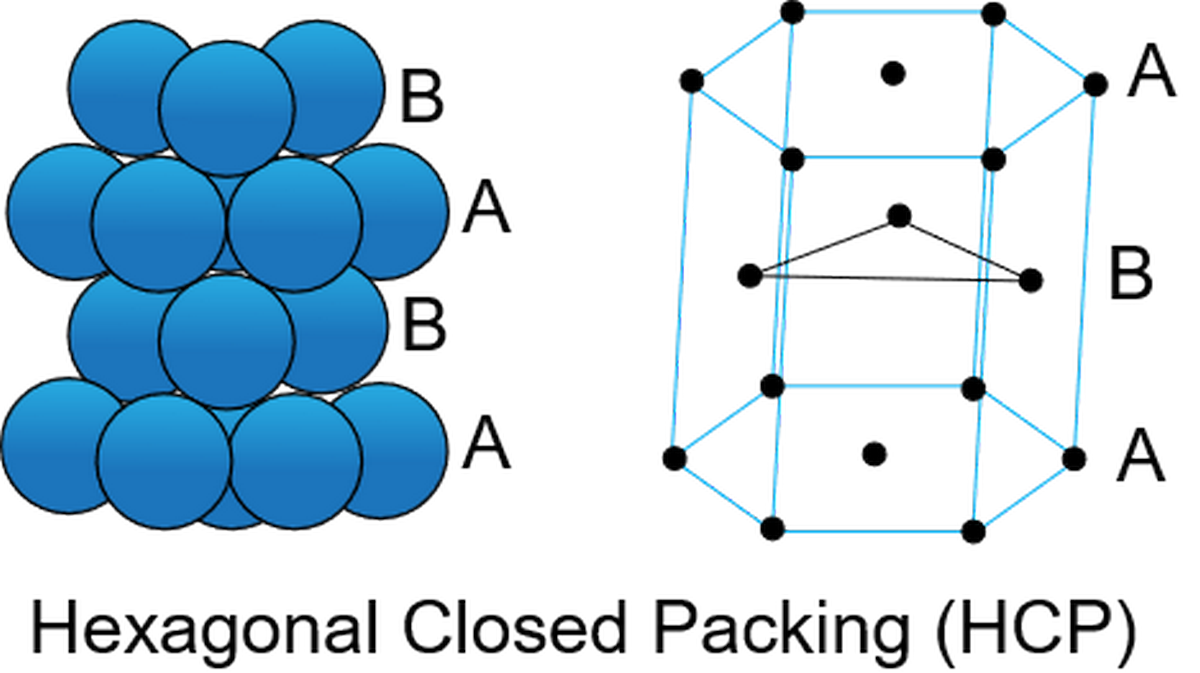
In hcp arrangement, the coordination number is 12 and only 26% space is free. A single unit cell has 4 atoms.
In cubic close packing (ccp): the spheres of third layer cover the octahedral voids of second layer. But the spheres of the fourth layers are aligned with those of the first layer. The pattern is ….ABCABC…. type. This arrangement has cubic symmetry and is know as cubic closed packed (ccp) arrangement. This is also called fcc arrangement.
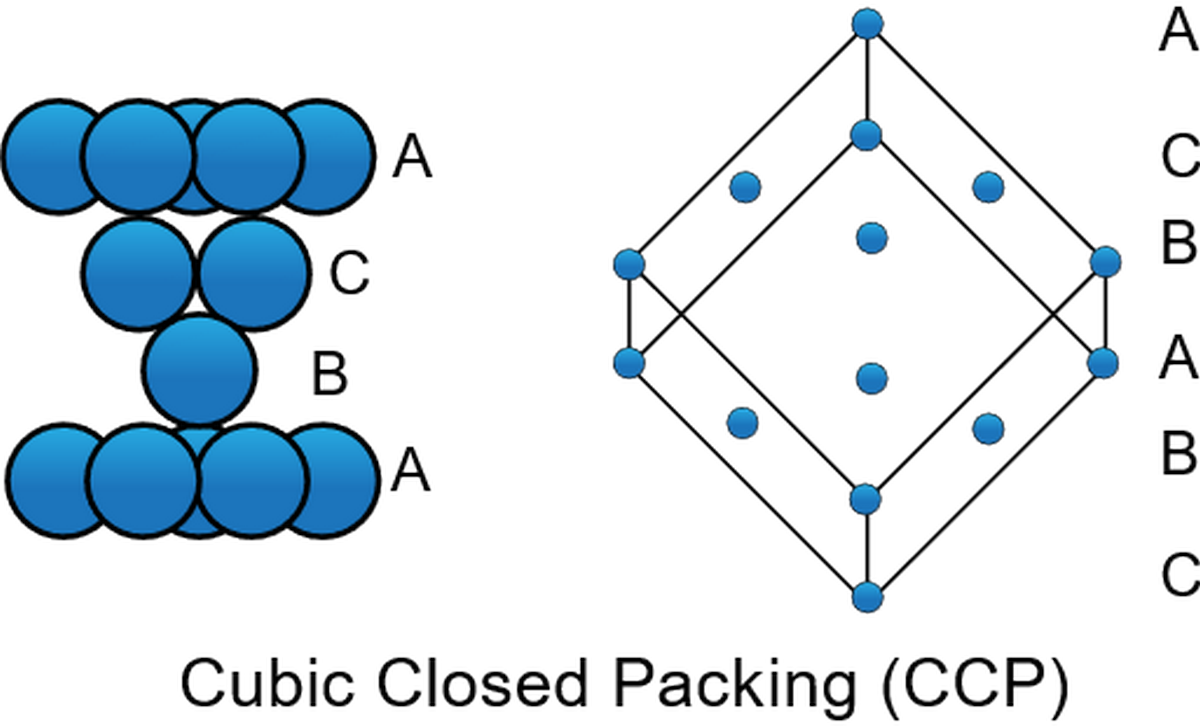
(ii) Crystal lattice and unit cell
Crystal lattice is the three dimensional arrangement of identical point in the space which represent how the constituent particles (atoms, ions, molecules) are arranged in a crystal. Each particle is depicted as a point.
Unit cell: Smallest portion of a crystal lattice which when repeated in different directions generates the entire lattice. Example: Brick is the unit cell of wall.
A unit cell is characterised by its edges length (a, b, c) and angles α, β and γ.

(iii) Tetrahedral void and octahedral void : Tetrahedral voids are surrounded by four spheres which lie at the vertices of a regular tetrahedron. There are 2 tetrahedral voids per atom in a crystal and radius ratio is 0.225.
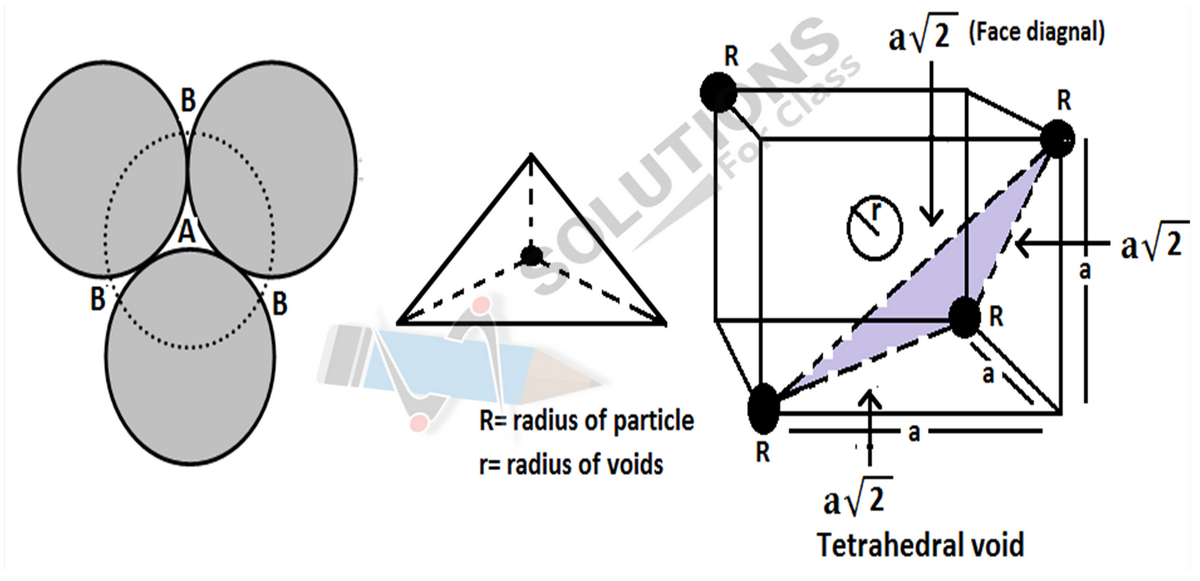
Octahedral voids are surrounded by six spheres and formed by a combination of two triangular voids of the first and second layer. There is one octahedral void per atom in a crystal and the radius ratio is 0.414.
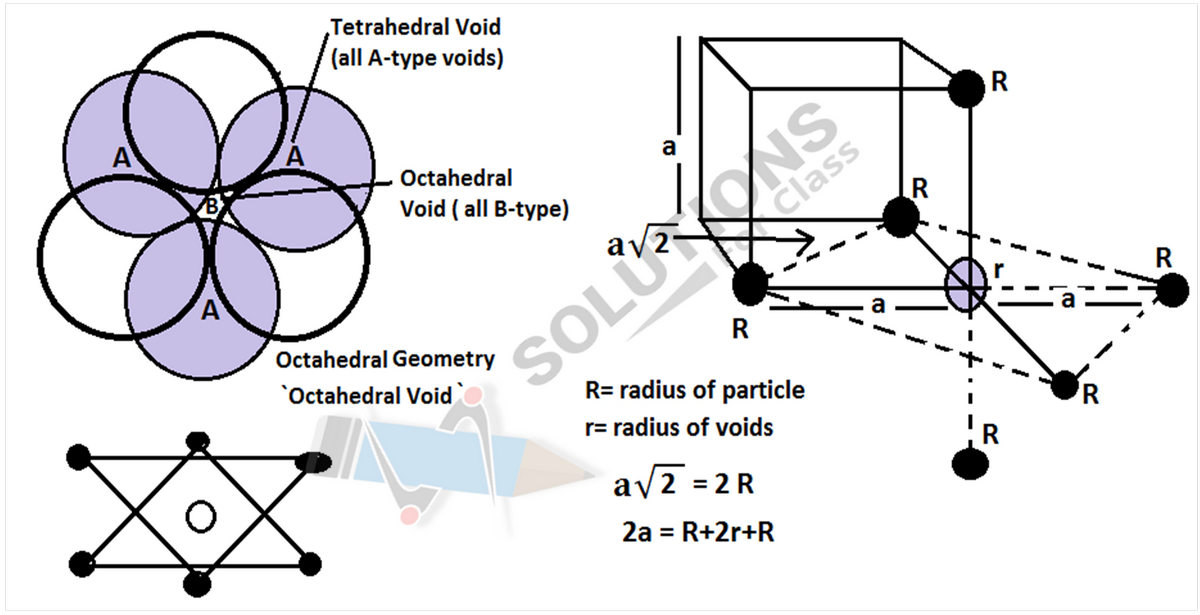
1.8 How many lattice points are there in one unit cell of each of the following lattice?
(i) Face-centred cubic
(ii) Face-centred tetragonal
(iii) Body-centred
Ans : (i) lattice points in face- centred cubic (Fcc)
= 8 (at corners) + 6 (at face centres) = 14
(ii) lattice points in Face-centred tetragonal
= 8 (at corners) + 6 (at face centres) = 14
(iii) lattice points in Body-centred (Bcc)
= 8 (at corners) + 1 (at body centres) = 9
1.9 Explain
(i) The basis of similarities and differences between metallic and ionic crystals.
(ii) Ionic solids are hard and brittle.
Ans: (i) Similarities between metallic and ionic crystals –
(a) Metallic and ionic crystals both have electrostatic force. In metallic crystals, it is found between e– and nucleus. In ionic crystals, it is found between cations and anions
(b) Bonds are non-directional in both the cases and both have high melting points (m.p.).
Differences: between metallic and ionic crystals
(a) In ionic crystal, the ions are not free to move. Hence, they cannot conduct electricity in solids state. They can conduct electricity only in die molten state or in aqueous solution. But in case of metallic crystals, they are good conductors of electricity in solid state as electrons are free to move.
(b) Ionic bond is strong due to strong electrostatic forces of attraction. Whereas, Metallic bond may be strong or weak depending upon the number of valence electrons and the size of the kernels.
(ii) Ionic solids are hard and brittle: Ionic solids are hard due to the presence of strong electrostatic forces of attraction. The brittleness in ionic crystals is due to the non- directional bonds in them.
1.10 Calculate the efficiency of packing in case of a metal crystal for
(i) simple cubic
(ii) body-centred cubic
(iii) face-centred cubic
Ans:
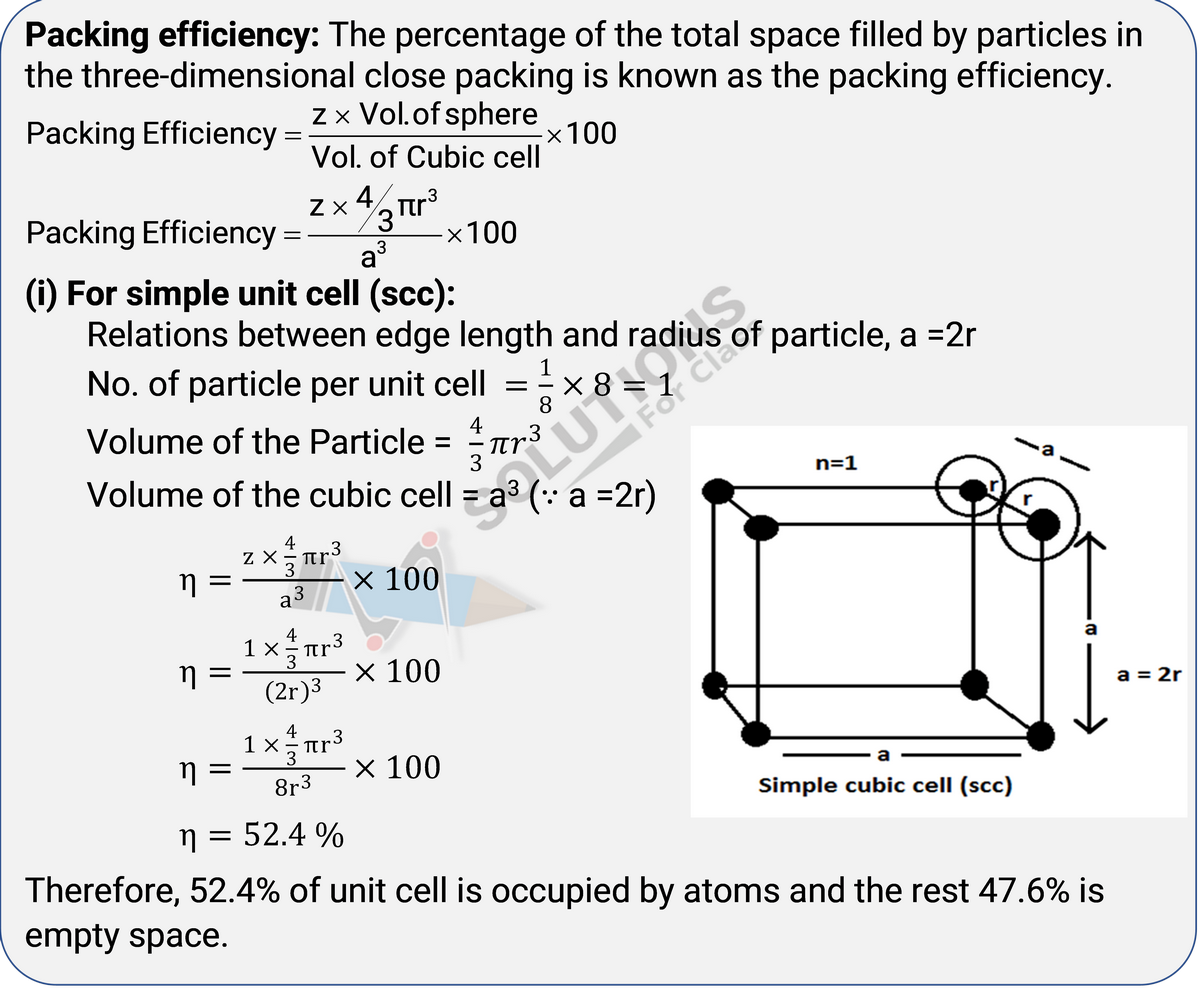
(ii) For body centred cubic unit cell

(iii) For face centred cubic cell (fcc)
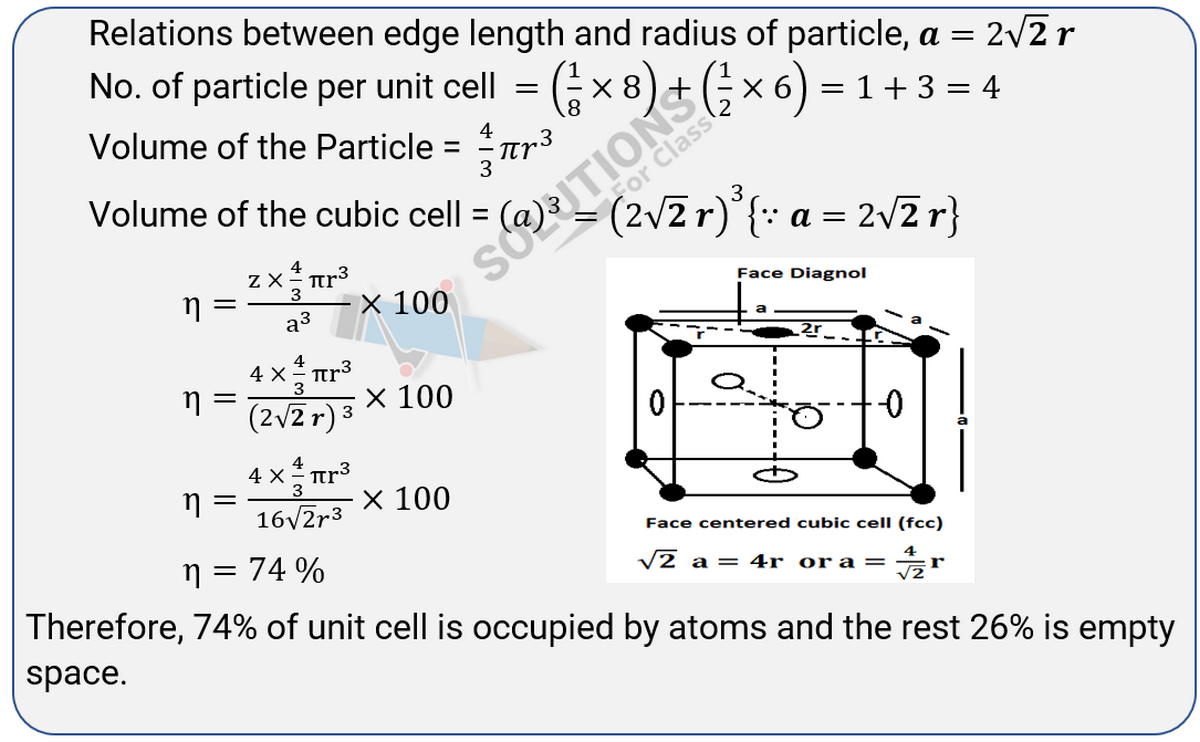
1.11 Silver crystallises in fcc lattice. If edge length of the cell is 4.07 × 10–8 cm and density is 10.5 g cm–3, calculate the atomic mass of silver.
Ans:
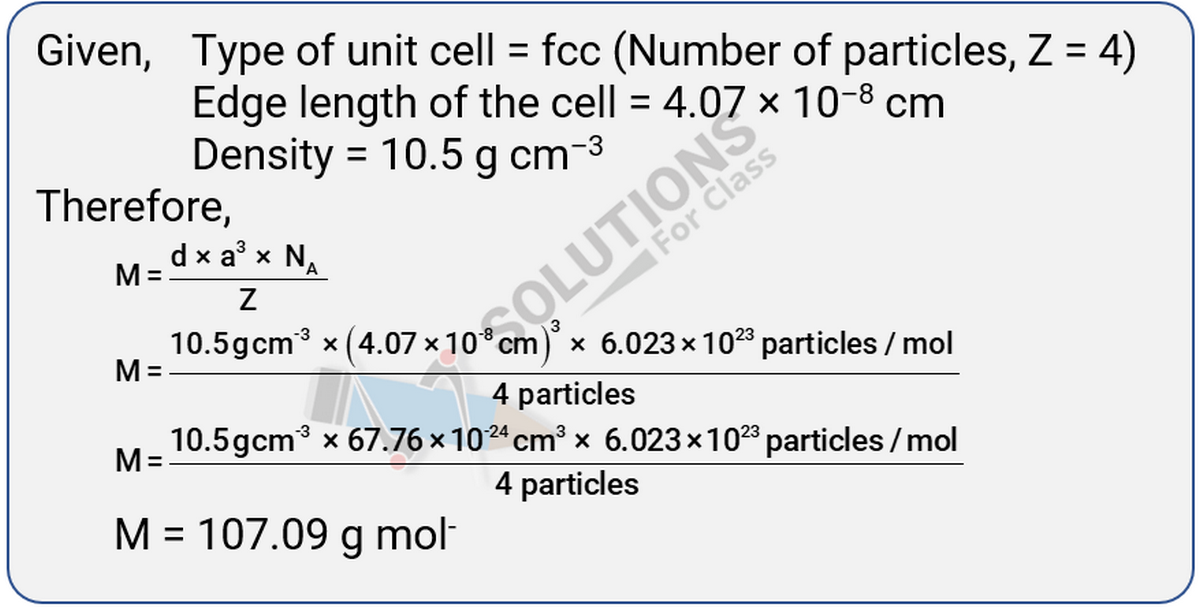
1.12 A cubic solid is made of two elements P and Q. Atoms of Q are at the corners of the cube and P at the body-centre. What is the formula of the compound? What are the coordination numbers of P and Q?
Ans:
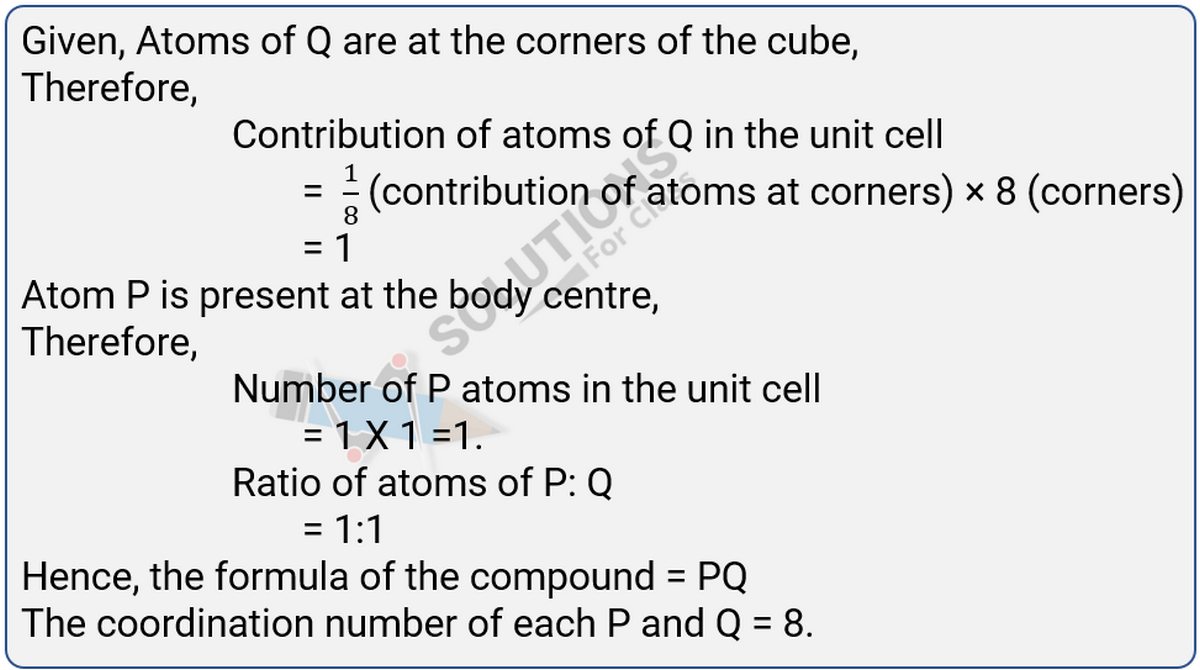
1.13 Niobium crystallises in body-centred cubic structure. If density is 8.55 g cm–3, calculate atomic radius of niobium using its atomic mass 93 u.
Ans:
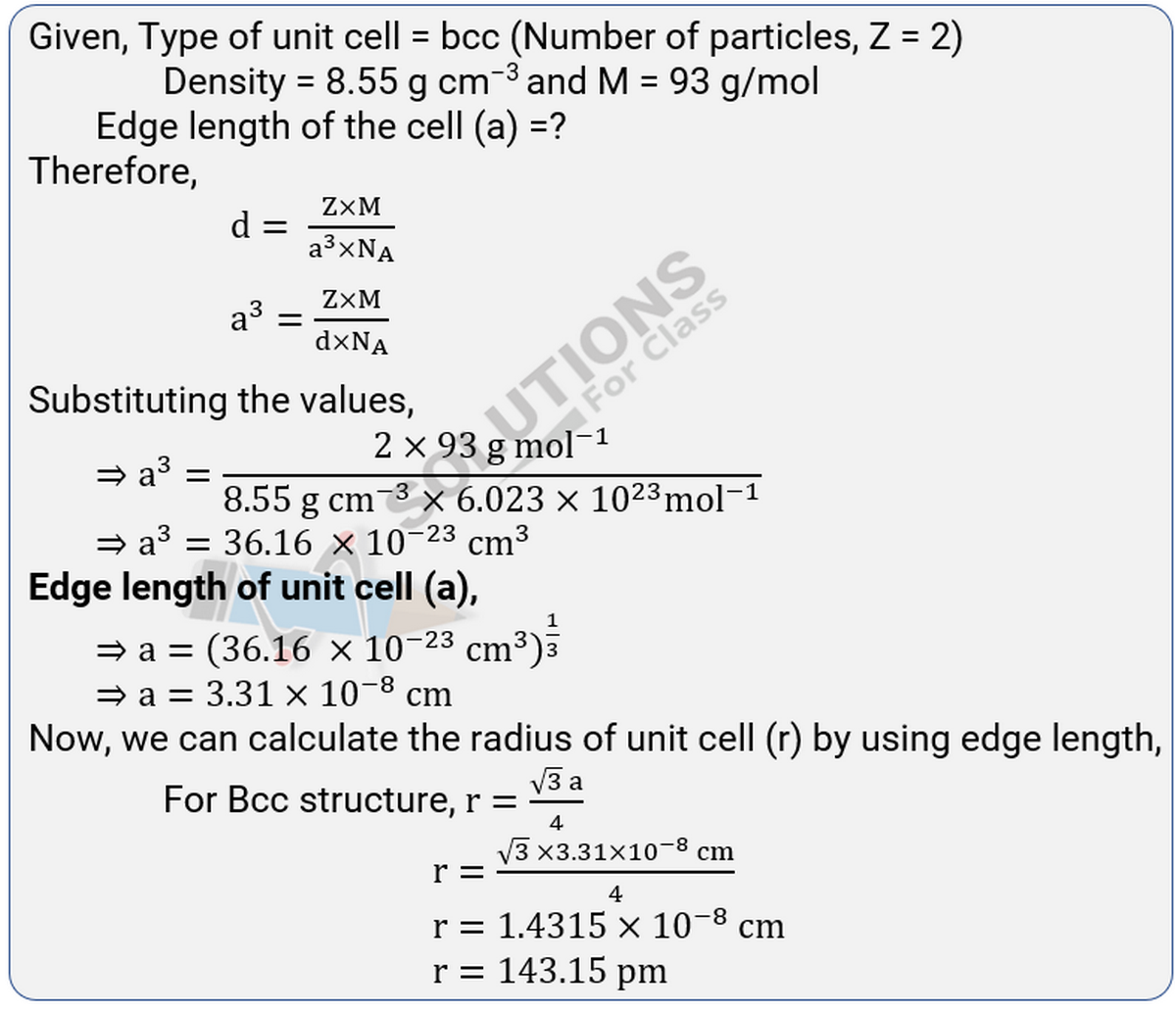
1.14 If the radius of the octahedral void is r and radius of the atoms in close- packing is R, derive relation between r and R.
Ans:
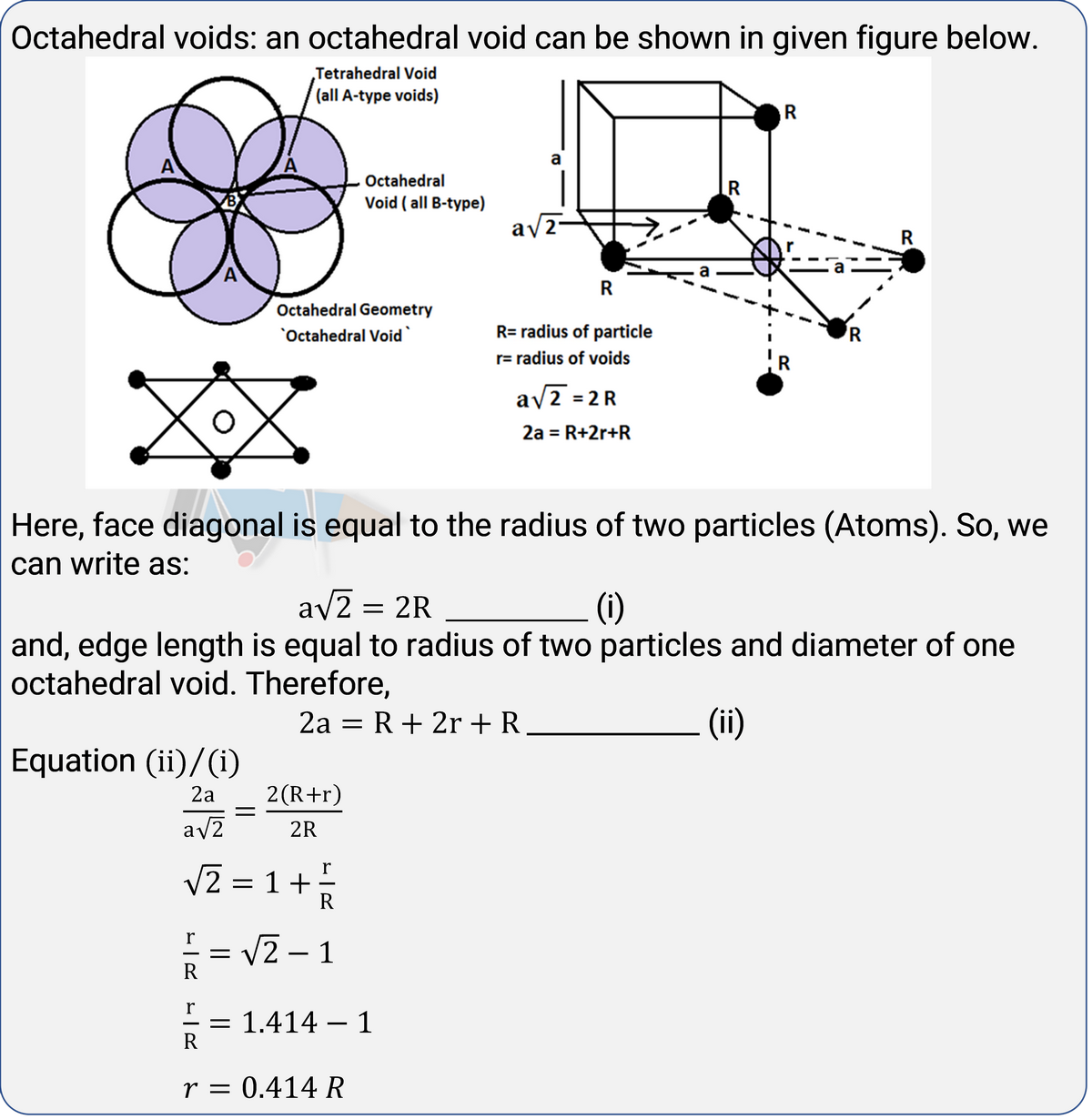
1.15 Copper crystallises into a fcc lattice with edge length 3.61 × 10–8 cm. Show that the calculated density is in agreement with its measured value of 8.92 g cm–3.
Ans:
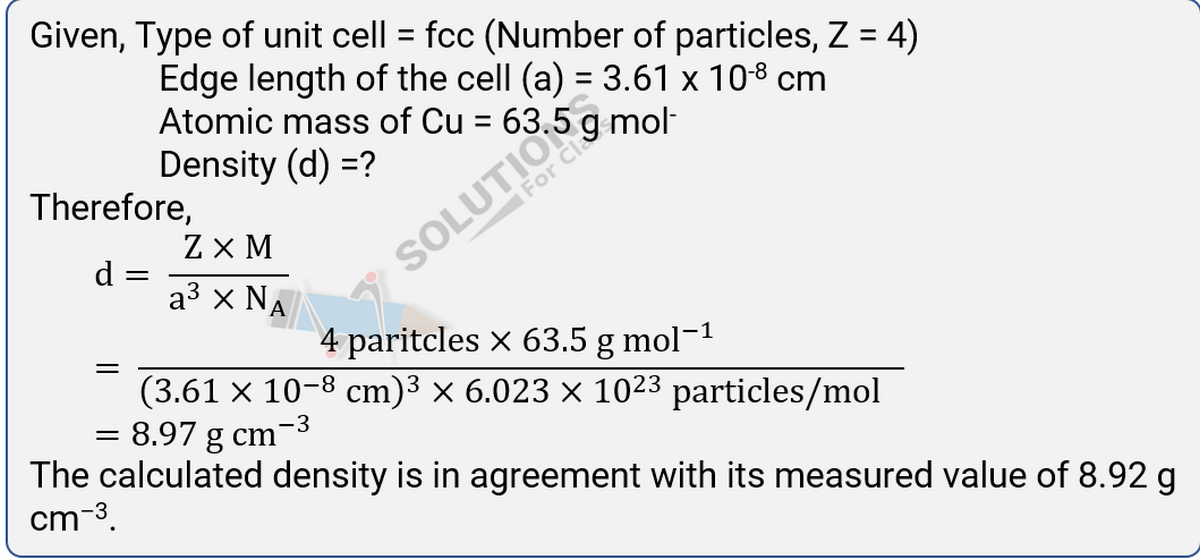
1.16 Analysis shows that nickel oxide has the formula Ni0.98O1.00. What fractions of nickel exist as Ni2+ and Ni3+ ions?
Ans:
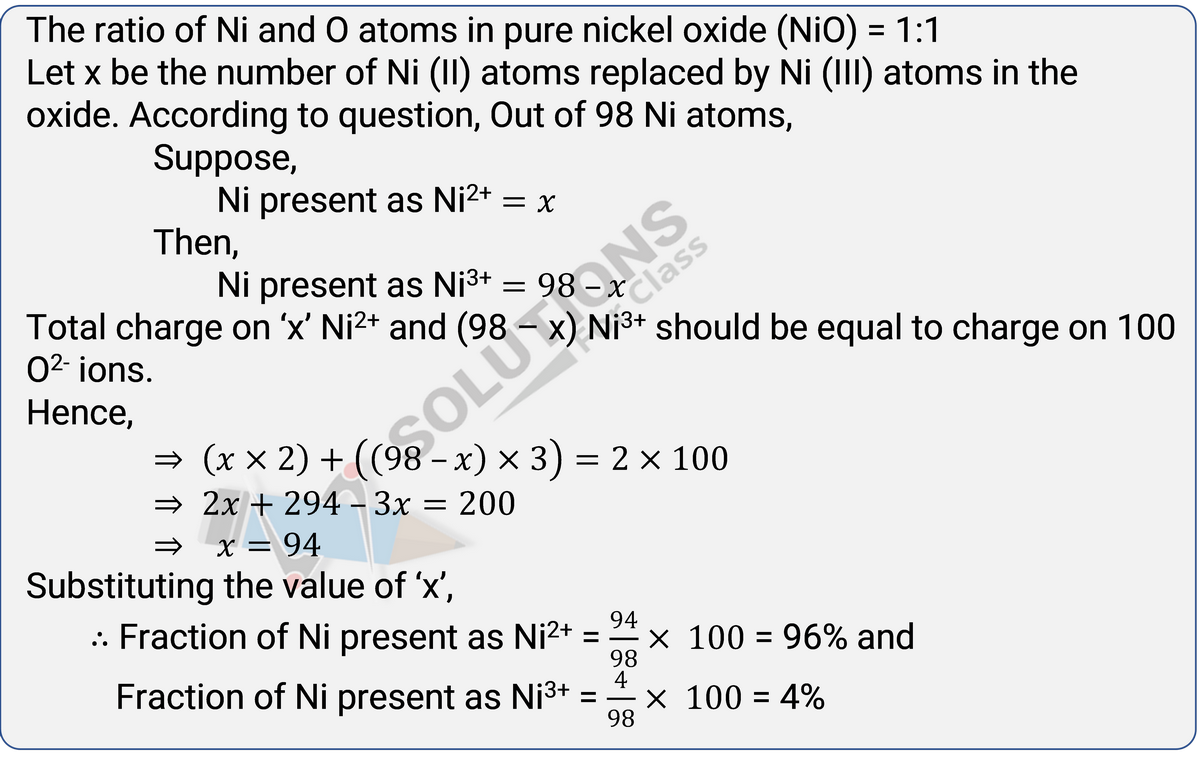
1.17 What is a semiconductor? Describe the two main types of semiconductors and contrast their conduction mechanism.
Ans: Semiconductors: The solids which have conductivities in the intermediate range from 10-6 to 104 ohm-1 m-1 are classified as semiconductor. As there is rise in the temperature, conductivity also increases because electrons from the valence band jump to conduction band.
Types of Semiconductors
(a) n-type semiconductor
(b) p-type semiconductor
(a) n-type semiconductor: When silicon or germanium crystal is doped with group 15 element like P or As, the dopant atom forms four covalent bonds like a Si or Ge atom but the fifth electron not used in bonding, becomes delocalised. These delocalized electrons increase the conductivity of doped silicon (or germanium). here the increase in conductivity is due to the negatively charged electron, hence silicon doped with electron-rich impurity is called n-type semiconductor.
(b) p-type semiconductor: When silicon or germanium is doped with group 13 element like B or Al. The dopant atom forms three covalent bond like a B or Al atom, but at the place of fourth electron a hole is created. Here, this hole moves through the crystal like a positive charge giving rise to electrical conductivity. Thus, Si or Ge doped with B or Al is called p-type of semiconductor, (p stands for positive hole) since, it is the positive hole that is responsible for conduction.

1.18 Non-stoichiometric cuprous oxide, Cu2O can be prepared in laboratory.In this oxide, copper to oxygen ratio is slightly less than 2:1. Can you account for the fact that this substance is a p-type semiconductor?
Ans: the ratio less than 2:1 in Cu2O shows that some cuprous (Cu+) ions have replaced by cupric ions (Cu2+). In order to maintain the electrical neutrality of the molecule, every two Cu+ ions will be replaced by one Cu2+ ion thereby creating a hole (Cation vacancies). Since, as the conduction is due to the presence of positive holes, it is a p-type semiconductor.
1.19 Ferric oxide crystallises in a hexagonal close-packed array of oxide ions with two out of every three octahedral holes occupied by ferric ions. Derive the formula of the ferric oxide.
Ans:
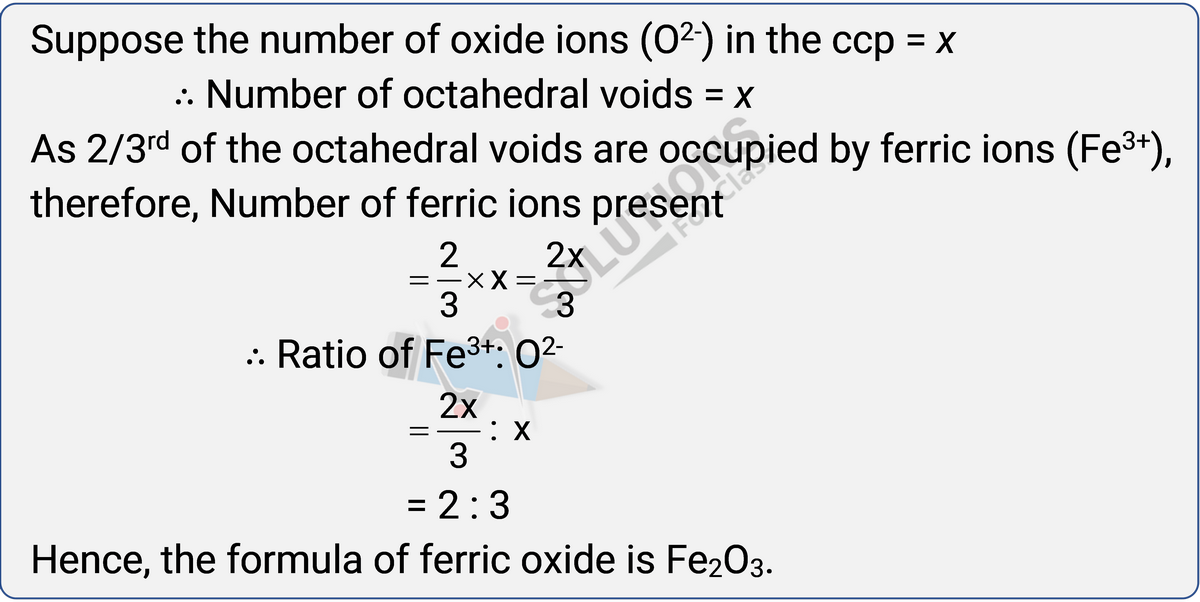
1.20 Classify each of the following as being either a p-type or a n-type semiconductor: (i) Ge doped with In (ii) B doped with Si.
Ans: (i) Ge doped with In, means In (group-13) is added to Ge (Group-14), hence an electron deficient hole is created and therefore, it is a p – type semiconductor.
(ii) B doped with Si, means, Si (group-14) is added to B (Group-13), hence there will be a free electron, so, it is an n-type semiconductor.
1.21 Gold (atomic radius = 0.144 nm) crystallises in a face-centred unit cell. What is the length of a side of the cell?
Ans: Given, Type of unit cell = fcc,
∴ r = 0.144 nm, a =?
For fcc, a = $2\sqrt{2}$r
= 2 × 1.414 × 0.144 nm
= 0.407 nm
1.22 In terms of band theory, what is the difference
(i) between a conductor and an insulator
(ii) between a conductor and a semiconductor?
Ans: (i) between a conductor and an insulator: The energy gap between the valence band and conduction band in an insulator is very large while in a conductor, the energy gap is very small or there is overlapping between valence band and conduction band.
(ii) between a conductor and a semiconductor: In a conductor, the valence band is partially filled or there is overlapping between valence band and conduction band while in semiconductor, there is always a small energy gap between them.
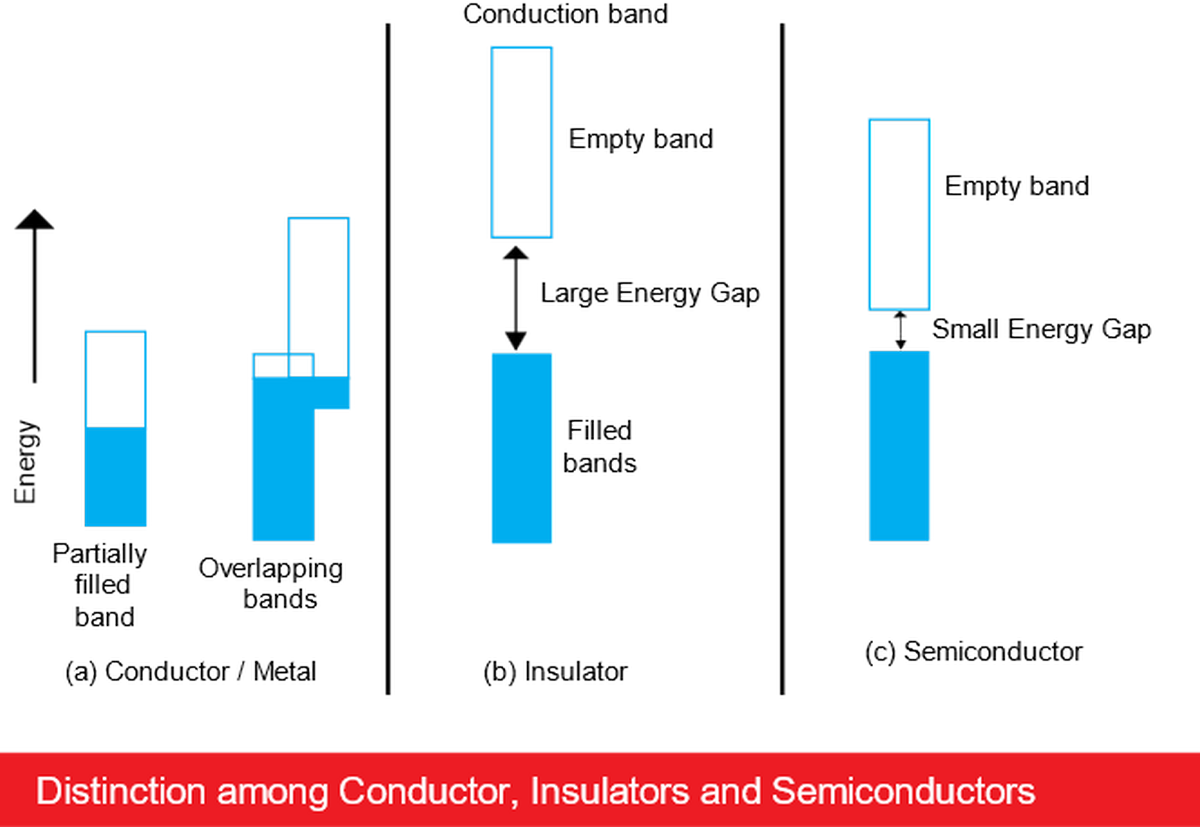
1.23 Explain the following terms with suitable examples:
(i) Schottky defect
(ii) Frenkel defect
(iii) Interstitials and
(iv) F-centres.
Ans:(i) Schottky defect : This defect arises when equal number of cations and anions are missing from the lattice. It is a common defect in ionic compounds of high coordination number where both cations and anions are of the same size, e.g. KCl, NaCl, KBr, etc. Due to this defect density of crystal decreases and it begins to conduct electricity to a smaller extent.
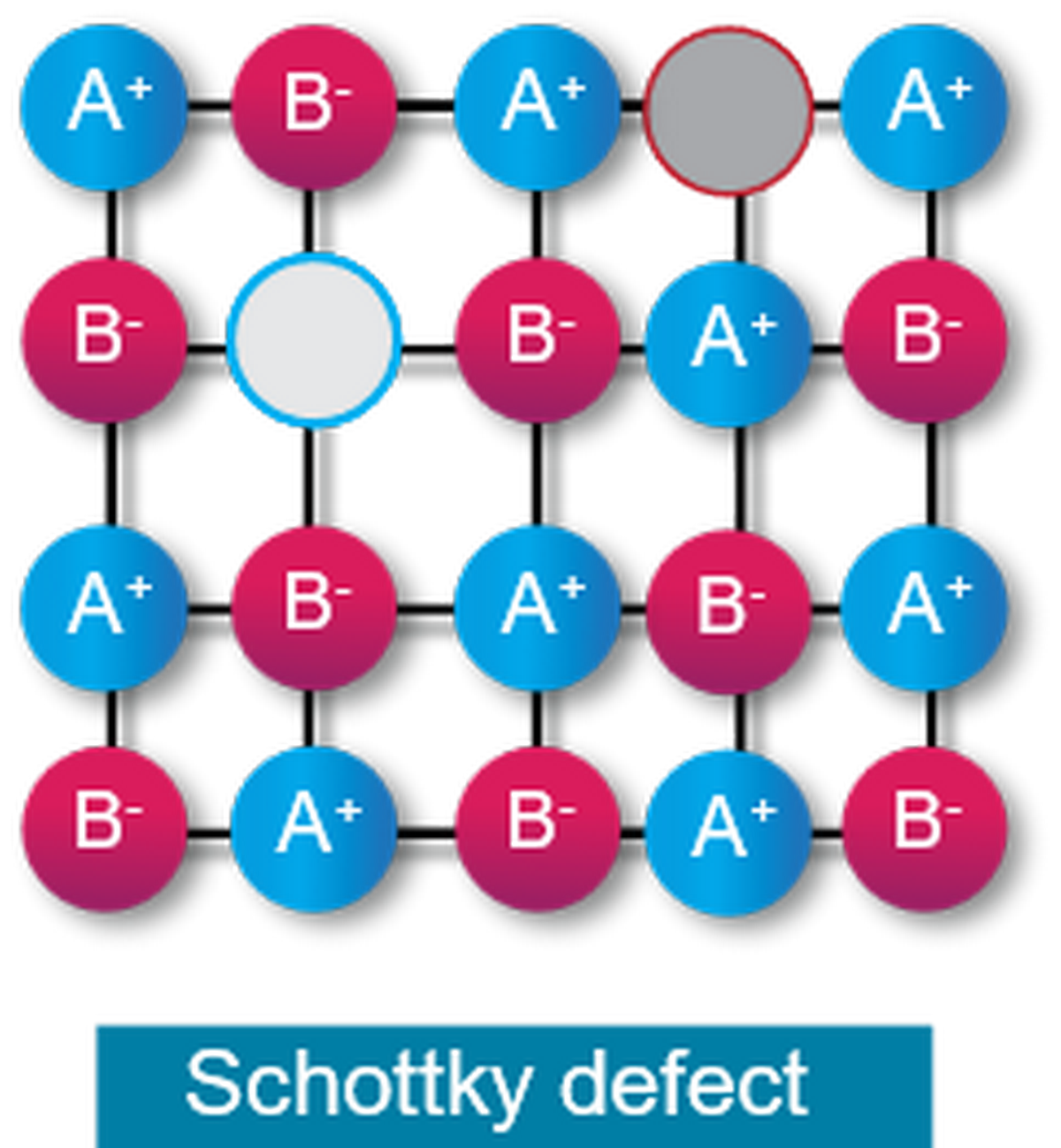
(ii) Frenkel defect : This defect arises when some of the ions of the lattice occupy interstitial sites leaving lattice sites vacant. This defect is generally found in ionic crystals where anion is much larger in size than the cation, e.g., AgBr, ZnS etc. Due to this defect density does not change, electrical conductivity increases to small extent and there is no change in overall composition of the crystal.

(iii) Interstitials: When some constituent particles (Atoms or ions) occupy a vacant interstitials sites (voids) in a crystal are called interstitials. It results in increase in density of the substance.
(iv) F-centres: When the anionic sites of a crystal are occupied by unpaired electrons, the ionic sites are called F-centres.These unpaired electrons impart colour to the crystals.
For example, when crystals of NaCl are heated in an atmosphere of sodium vapour, the sodium atoms are deposited on the surface of the crystal. The ions diffuse from the crystal to its surface and combine with Na atoms, forming NaCl. During this process, the Na atoms on the surface of the crystal lose electrons. These released electrons diffuse into the crystal and occupy the vacant anionic sites, creating F-centres.
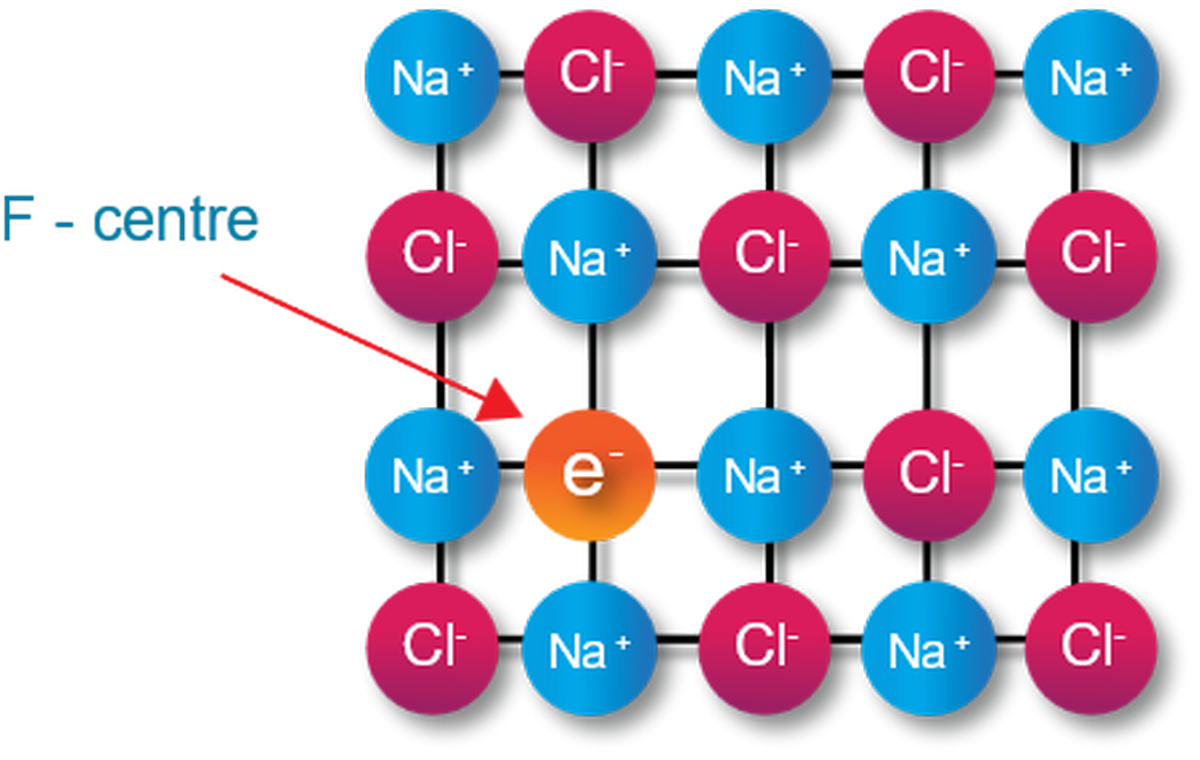
This unpaird electron is responsible for the colour. The colour results by excitation of these electrons when they absorb energy from the visible light falling on the crystals.
This defect is common in NaCl, KCl, LiCl, etc. Due to this effect NaCl crystal imparts yellow color, KCl imparts violet color and LiCl imparts pink color.
1.24 Aluminium crystallises in a cubic close-packed structure. Its metallic radius is 125 pm.
(i) What is the length of the side of the unit cell?
(ii) How many unit cells are there in 1.00 cm3 of aluminium?
Ans: Given,
Type of closed packing = ccp
Radius of particle (r) = 125 pm
And also, ccp has fcc type of unit cell.
Therefore,
(i) For ccp (fcc), length of the side of the unit cell
$a=2\sqrt{2}r$
a = 2 × 1.414 × 125 pm
a = 353.5 pm
(ii) To calculate number of unit cell in given 1.00 cm3 volume,
Volume of unit cell = a3 = (353.5 × 10-10) cm3
= 4.42 × 10-23 cm3
Hence, number of unit cell in 1.00 cm3
$=\frac{Volume\,\,of\,\,Al}{Volume\,\,of\,\,Unit\,\,Cell}$
$=\frac{1\,c{{m}^{3}}}{4.42\times {{10}^{-25}}c{{m}^{3}}}=2.26\times {{10}^{22}}\,\,unit\,\,cells$
1.25 If NaCl is doped with 10–3 mol % of SrCl2, what is the concentration of cation vacancies?
Ans: NaCl is doped with 10–3 mol % of SrCl2 i.e.,
∵100 mol of NaCl are doped with 10-3 mol of SrCl2
∴ 1 mol of NaCl is doped with SrCl2 $=\frac{{{10}^{-3}}}{100}mol={{10}^{-5}}\,\,mol$
Each Sr2+ will replace two Na+ ions. To maintain electrical neutrality, it occupies one position and thus creates one cation vacancy.
Therefore,
Concentration of cation vacancies (total number)
= (10-5 mol) × (6.23×1023 mol-1)
= 6.02 ×1018
1.26 Explain the following with suitable examples:
(i) Ferromagnetism
(ii) Paramagnetism
(iii) Ferrimagnetism
(iv) Antiferromagnetism
(v) 12-16 and 13-15 group compounds.
Ans: (i) Ferromagnetism: The substances which are strongly attracted by magnetic field. The metal ions of these substances are grouped together into small regions called domains. Thus, each domain acts as a tiny magnet. When the substance is placed in a magnetic field all the domains get oriented in the direction of the magnetic field and a strong magnetic effect is produced. This ordering of domains persists even when the magnetic field is removed and the ferromagnetic substance becomes a permanent magnet.
Example: Fe, Ni, Co, CrO2.
(ii) Paramagnetism: Which are weakly attracted by external magnetic field. It is shown by substances which contain unpaired e–. In magnetic field, these tend to orient themselves parallel to the direction of the field and thus, produce magnetism in the substances. However, they loose their magnetism in the absence of magnetic field. Examples of paramagnetic substance are O2, Cu2+, Fe3+, Cr3+, TiO, VO2 etc.
(iii) Ferrimagnetism: When unequal number of domains are aligned in opposite directions, the net magnetic moment is not zero. Such substances are termed as ferrimagnetic substances.
- They are weakly attracted by magnetic field as compared to ferromagnetic substances.
- These substances also lose ferrimagnetism on heating and become paramagnetic.
- Example: Fe3O4(Magnetite), MgFe2O4 (ferrites), ZnFe2O4
(iv) Antiferromagnetism: Substances which possess zero net magnetic moment. It is due to presence of equal number of domains in opposite directions. For example: MnO, Mn2O3
(v) 12-16 and 13-15 group compounds:
(i)12-16 compounds: combination of elements of groups 12 and 16 yield some solid compounds which are known as 12-16 compounds. These compounds have ionic character along with covalent. The ionic character depends on the electronegativities of the two elements. For example, ZnS, CdS, CdSe, HgTe etc.
(ii) 13-15 compounds: combination of elements of groups 13 and 15 yield compounds which are known as 13-15 compounds. For example, InSb, AlP, GaAs, etc. Gallium arsenide (GaAs) semiconductors have very fast response and have revolutionised the design of semiconductor devices such as Infrared light- emitting diodes, laser diodes, solar cells etc.

